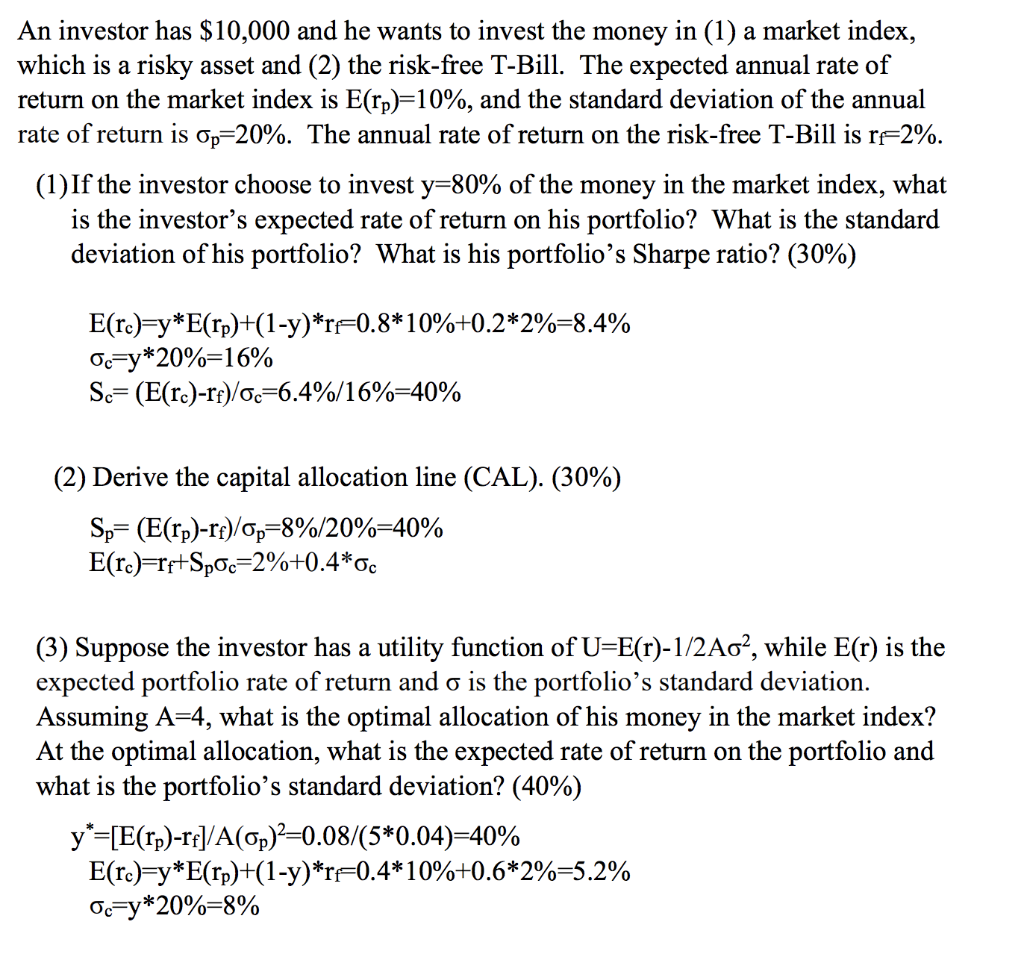
An investor has $10,000 and he wants to invest the money in (1) a market index, which is a risky asset and (2) the risk-free T-Bill. The expected annual rate of return on the market index is E(rp)=10%, and the standard deviation of the annual rate of return is Op=20%. The annual rate of return on the risk-free T-Bill is re2%. (1)If the investor choose to invest y=80% of the money in the market index, what is the investor's expected rate of return on his portfolio? What is the standard deviation of his portfolio? What is his portfolio's Sharpe ratio? (30%) E(rc)=y*E(rp)+(1-y)*r 0.8*10%+0.2*2%=8.4% Oc=y*20%=16% Sc=(E(rc)-rf)/oc=6.4%/16%=40% (2) Derive the capital allocation line (CAL). (30%) Sp= (E(rp)-r+)/(p=8%/20%=40% E(rc)=rf+Sp&c=2%+0.4*6c (3) Suppose the investor has a utility function of U=E(r)-1/2A02, while E(r) is the expected portfolio rate of return and o is the portfolio's standard deviation. Assuming A=4, what is the optimal allocation of his money in the market index? At the optimal allocation, what is the expected rate of return on the portfolio and what is the portfolio's standard deviation? (40%) y*=[E(rp)-rf]/A(OP)2=0.08/(5*0.04)=40% E(rc)=y*E(rp)+(1-y)*r 0.4*10%+0.6*2%=5.2% Oc=y*20%=8% An investor has $10,000 and he wants to invest the money in (1) a market index, which is a risky asset and (2) the risk-free T-Bill. The expected annual rate of return on the market index is E(rp)=10%, and the standard deviation of the annual rate of return is Op=20%. The annual rate of return on the risk-free T-Bill is re2%. (1)If the investor choose to invest y=80% of the money in the market index, what is the investor's expected rate of return on his portfolio? What is the standard deviation of his portfolio? What is his portfolio's Sharpe ratio? (30%) E(rc)=y*E(rp)+(1-y)*r 0.8*10%+0.2*2%=8.4% Oc=y*20%=16% Sc=(E(rc)-rf)/oc=6.4%/16%=40% (2) Derive the capital allocation line (CAL). (30%) Sp= (E(rp)-r+)/(p=8%/20%=40% E(rc)=rf+Sp&c=2%+0.4*6c (3) Suppose the investor has a utility function of U=E(r)-1/2A02, while E(r) is the expected portfolio rate of return and o is the portfolio's standard deviation. Assuming A=4, what is the optimal allocation of his money in the market index? At the optimal allocation, what is the expected rate of return on the portfolio and what is the portfolio's standard deviation? (40%) y*=[E(rp)-rf]/A(OP)2=0.08/(5*0.04)=40% E(rc)=y*E(rp)+(1-y)*r 0.4*10%+0.6*2%=5.2% Oc=y*20%=8%







